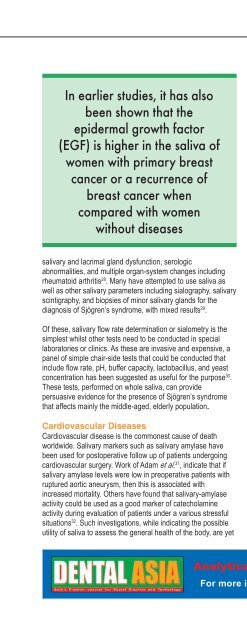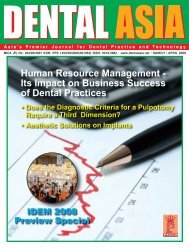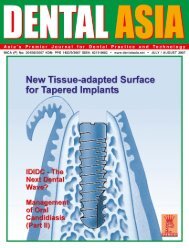Download - Dental Asia
Download - Dental Asia
Download - Dental Asia
You also want an ePaper? Increase the reach of your titles
YUMPU automatically turns print PDFs into web optimized ePapers that Google loves.
CLINICALUPDATE<br />
In earlier studies, it has also<br />
been shown that the<br />
epidermal growth factor<br />
(EGF) is higher in the saliva of<br />
women with primary breast<br />
cancer or a recurrence of<br />
breast cancer when<br />
compared with women<br />
without diseases<br />
salivary and lacrimal gland dysfunction, serologic<br />
abnormalities, and multiple organ-system changes including<br />
rheumatoid arthritis 28 . Many have attempted to use saliva as<br />
well as other salivary parameters including sialography, salivary<br />
scintigraphy, and biopsies of minor salivary glands for the<br />
diagnosis of Sjögren’s syndrome, with mixed results 29 .<br />
Of these, salivary flow rate determination or sialometry is the<br />
simplest whilst other tests need to be conducted in special<br />
laboratories or clinics. As these are invasive and expensive, a<br />
panel of simple chair-side tests that could be conducted that<br />
include flow rate, pH, buffer capacity, lactobacillus, and yeast<br />
concentration has been suggested as useful for the purpose 30 .<br />
These tests, performed on whole saliva, can provide<br />
persuasive evidence for the presence of Sjögren’s syndrome<br />
that affects mainly the middle-aged, elderly population.<br />
Cardiovascular Diseases<br />
Cardiovascular disease is the commonest cause of death<br />
worldwide. Salivary markers such as salivary amylase have<br />
been used for postoperative follow up of patients undergoing<br />
cardiovascular surgery. Work of Adam et al. 31 , indicate that if<br />
salivary amylase levels were low in preoperative patients with<br />
ruptured aortic aneurysm, then this is associated with<br />
increased mortality. Others have found that salivary-amylase<br />
activity could be used as a good marker of catecholamine<br />
activity during evaluation of patients under a various stressful<br />
situations 32 . Such investigations, while indicating the possible<br />
utility of saliva to assess the general health of the body, are yet<br />
in the early stages of development and more work is required<br />
to confirm their general usefulness.<br />
Endocrinology<br />
Measurements of salivary hormone levels are of clinical<br />
relevance if they accurately reflect the serum hormone levels or<br />
if a constant correlation exists between salivary and serum<br />
hormone levels. Although there is wide disparity in these values<br />
for some hormones salivary steroid levels are in general good<br />
indicators of their blood concentrations.<br />
Consequently, the use of saliva for monitoring of steroid<br />
hormone levels is now feasible and commercially available with<br />
dedicated websites on the internet (e.g. http://<br />
www.salivatest.com/journals/saliva_ref.html ). At present, the<br />
following steroid levels can be assessed using mixed saliva:<br />
cortisol, estradiol, estriol, dehydroepiandrosterone,<br />
progesterone and testosterone. As opposed to these serum<br />
levels of protein hormones such as prolactin and thyrotropin<br />
can not be evaluated by salivary analyses as the latter<br />
molecules are too large to reach saliva through passive<br />
diffusion.<br />
The clinical utility of steroid hormone evaluation have been<br />
demonstrated in a wide variety of situations ranging from<br />
assessment of child health and development, mood and<br />
cognitive emotional behavior, premenstrual depression,<br />
Cushing’s syndrome, ovarian function and monitoring full-term<br />
and preterm neonates.<br />
Oncology<br />
The use of saliva as a predictable and a sensitive marker for<br />
detection of either oral or systemic cancers appears to be a<br />
practical reality. In a recent landmark study Wong et al. 33 ,<br />
noticed seven messenger RNAs in particular that were present<br />
at a 3.5-fold higher level in patients with oral carcinomas.<br />
(mRNA is the molecular intermediate between gene and<br />
protein, serving as a chemical record that an individual gene<br />
has been expressed). The latter workers then reduced their list<br />
of signature mRNAs to four, based on statistical models that<br />
indicated the synchronized rise in expression of these four<br />
molecules increased the probability that the saliva belonged to<br />
a cancer patient.<br />
These four mRNAs were from the following genes: Interleukin<br />
1-beta (IL1B), Ornithine decarboxylase antizyme 1 (OAZ1),<br />
spermidine/spermine N1-acetyl transferase (SAT), and<br />
interleukin 8 (IL-8). To put this idea to the test, Wong et al. 33 ,<br />
Analytical • Authoritative • Acclaimed<br />
For more information, email: info@pabloasia.com<br />
<strong>Dental</strong> <strong>Asia</strong> • May / June 2008<br />
21





